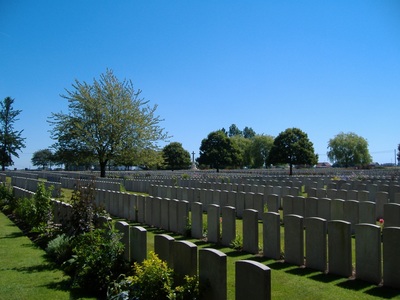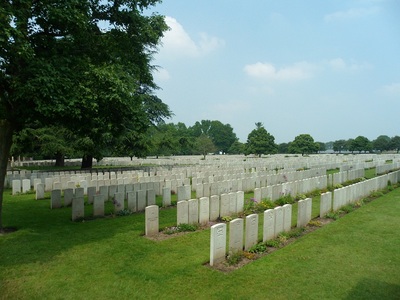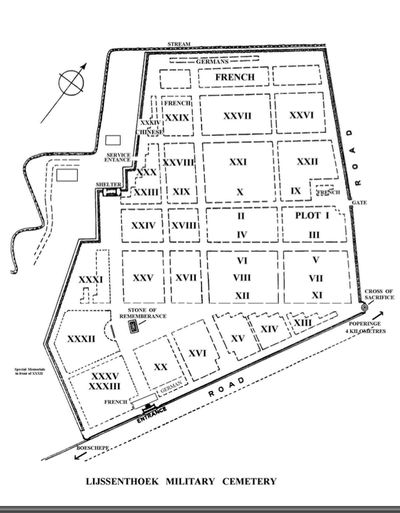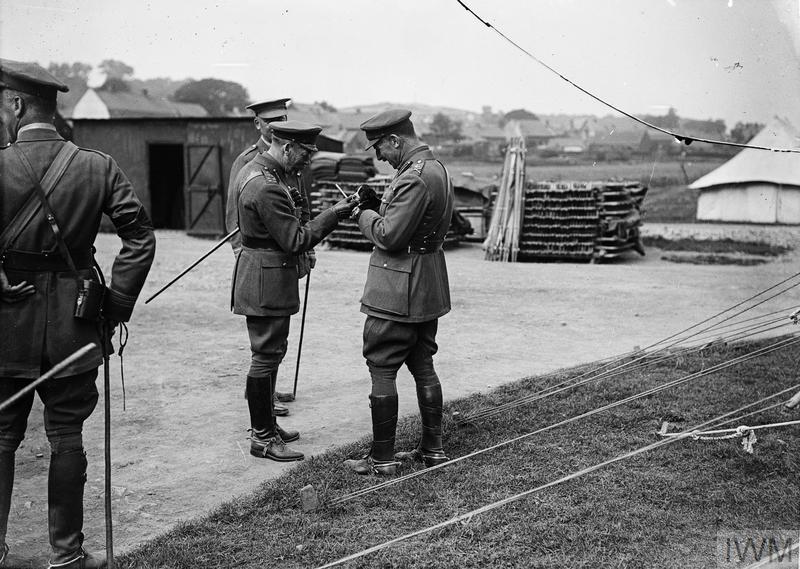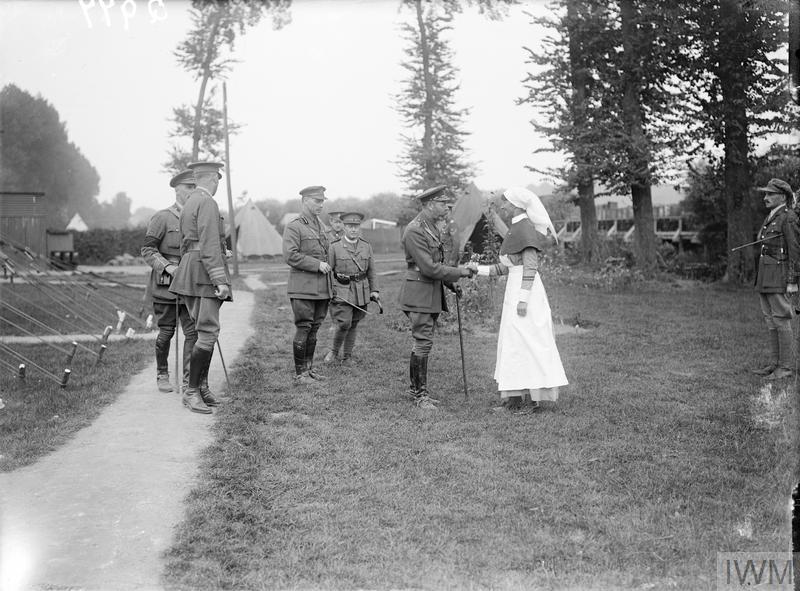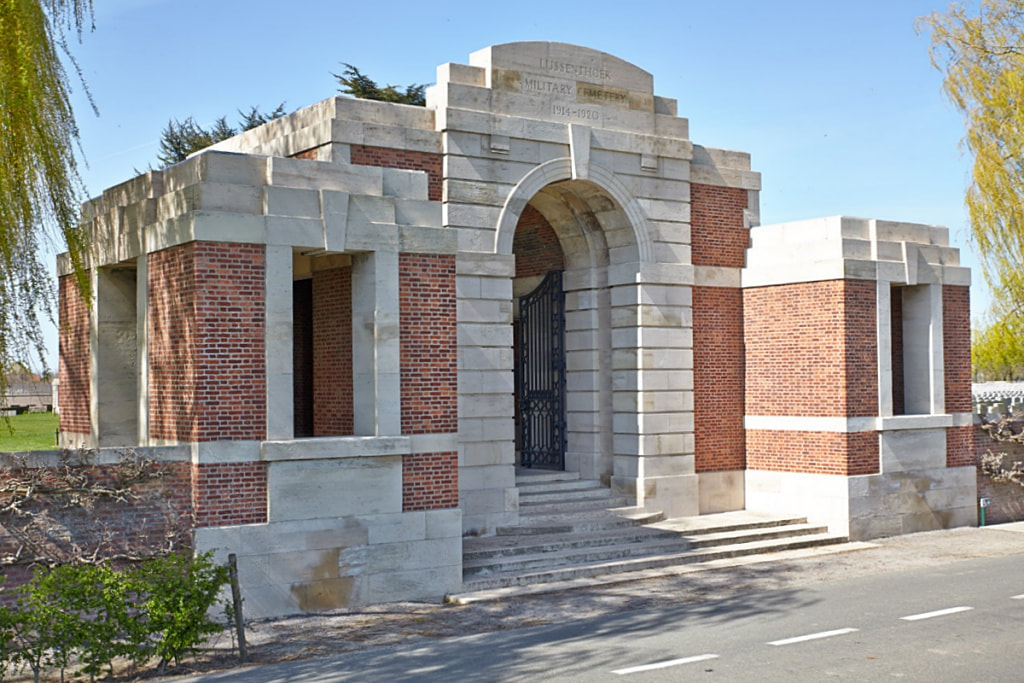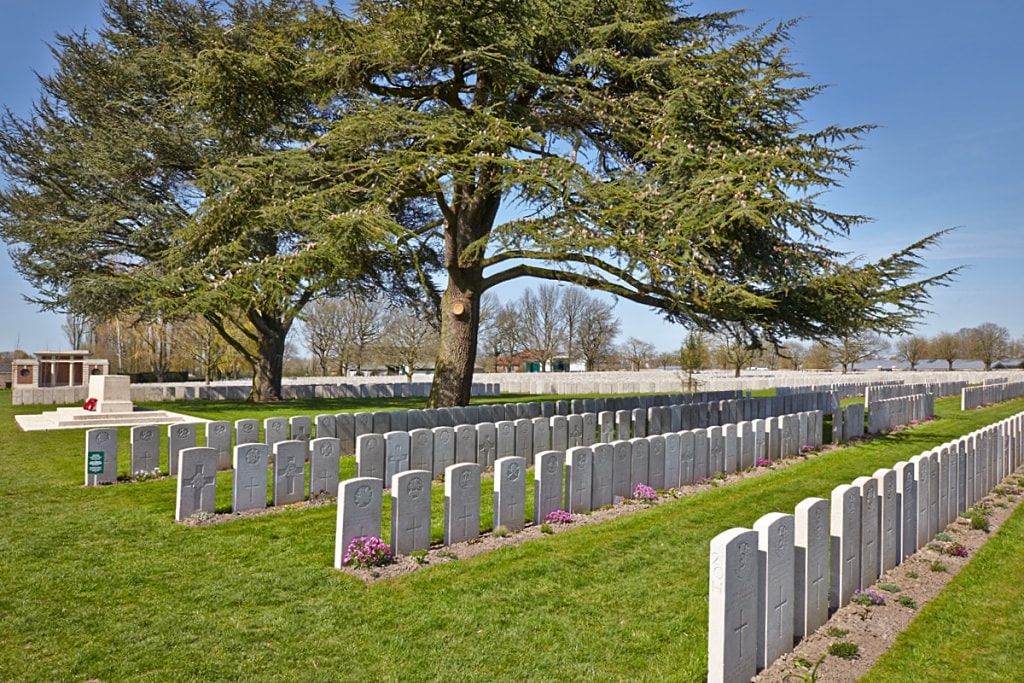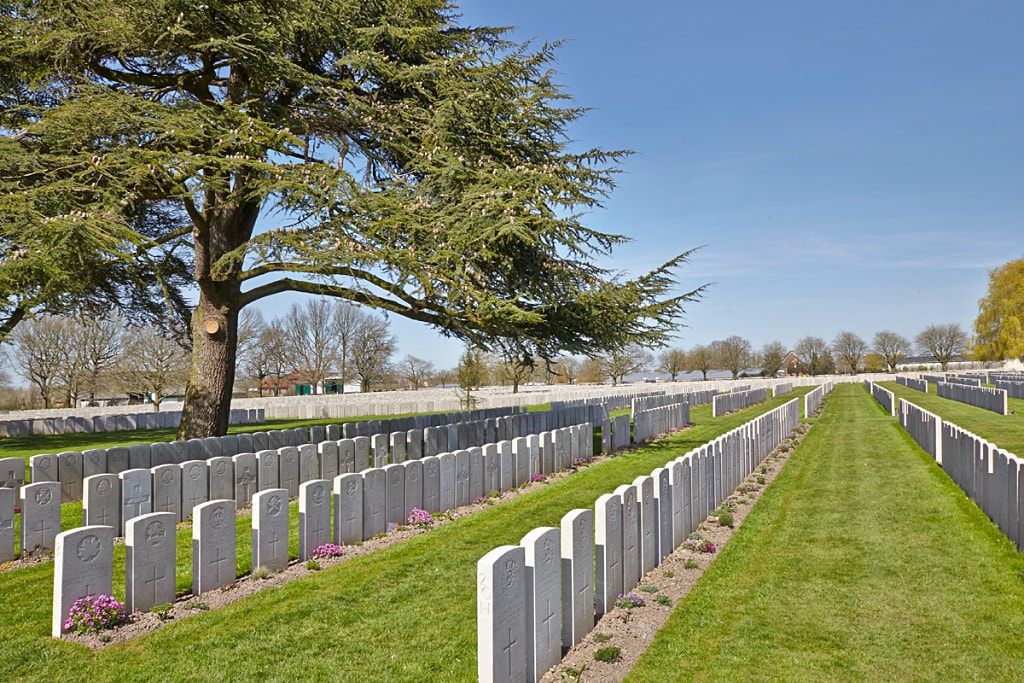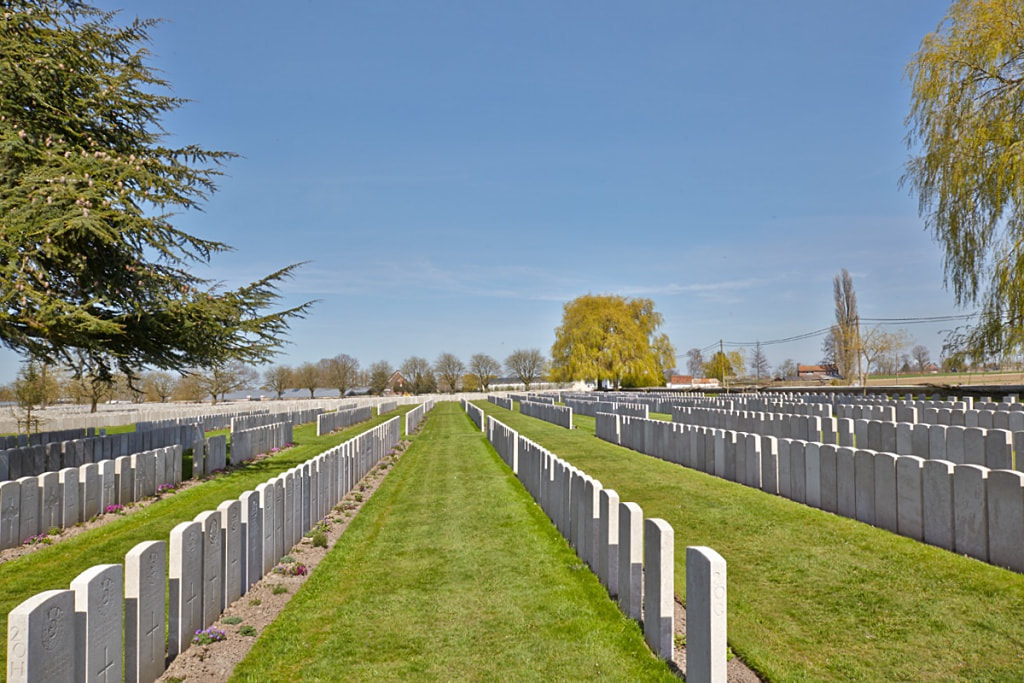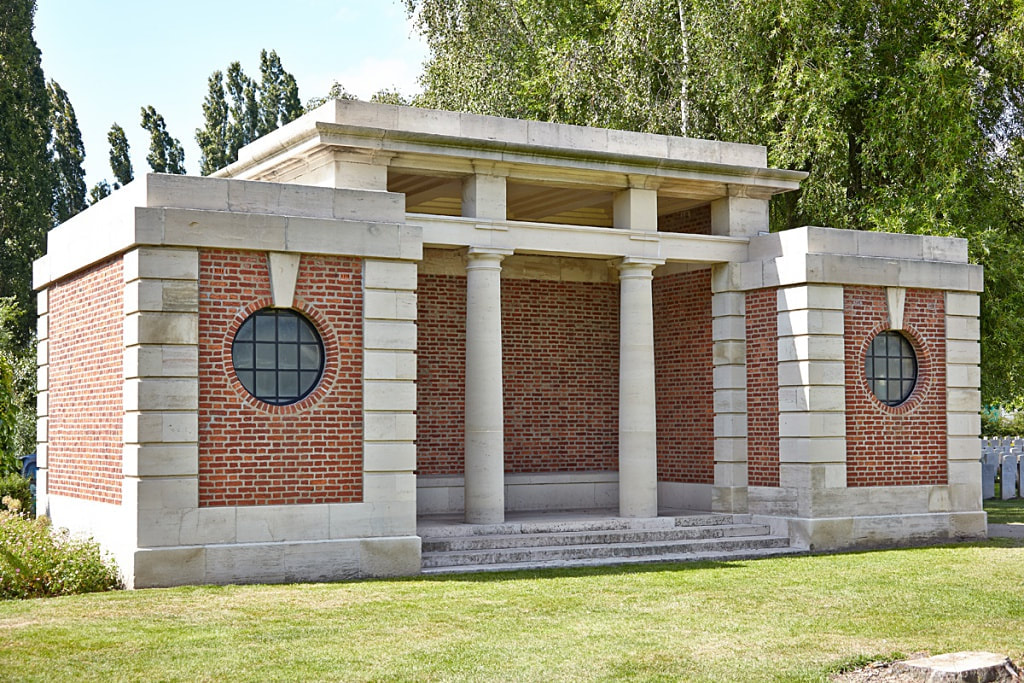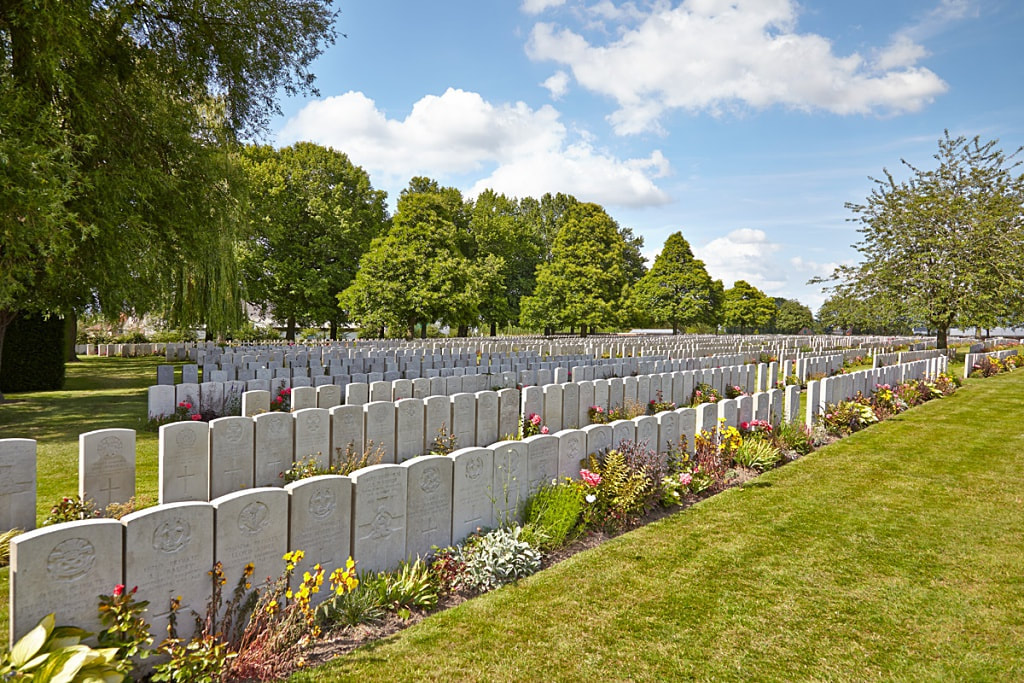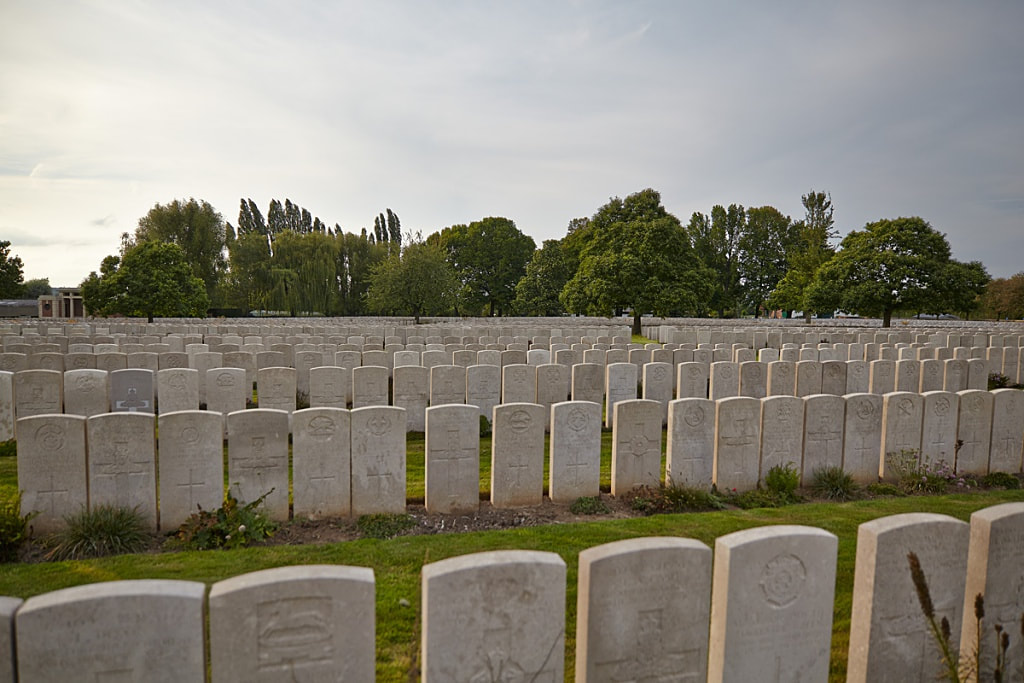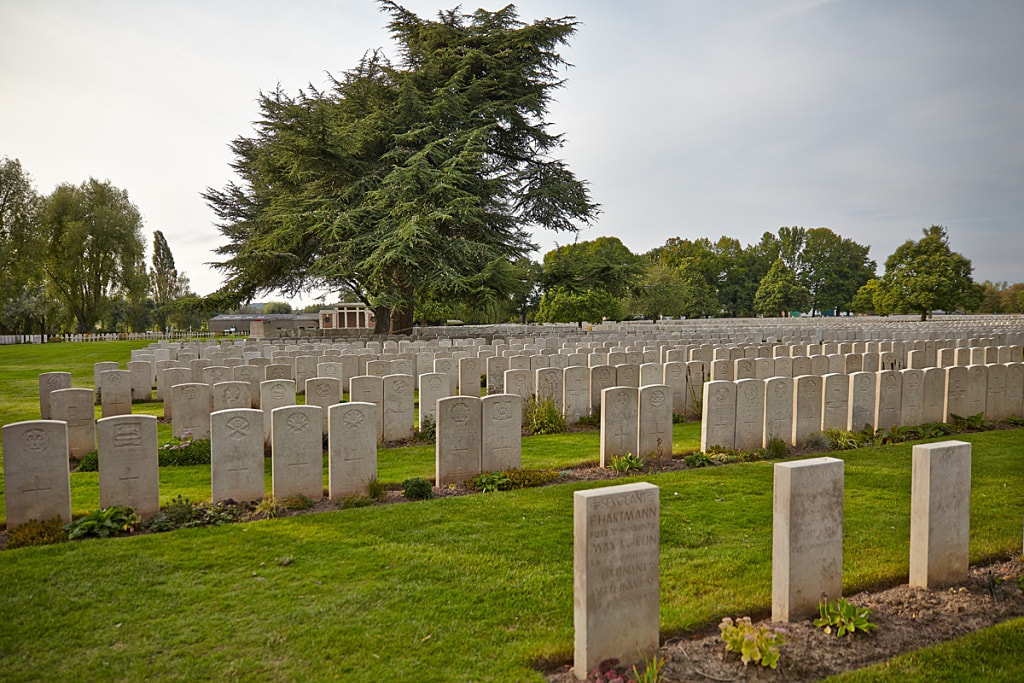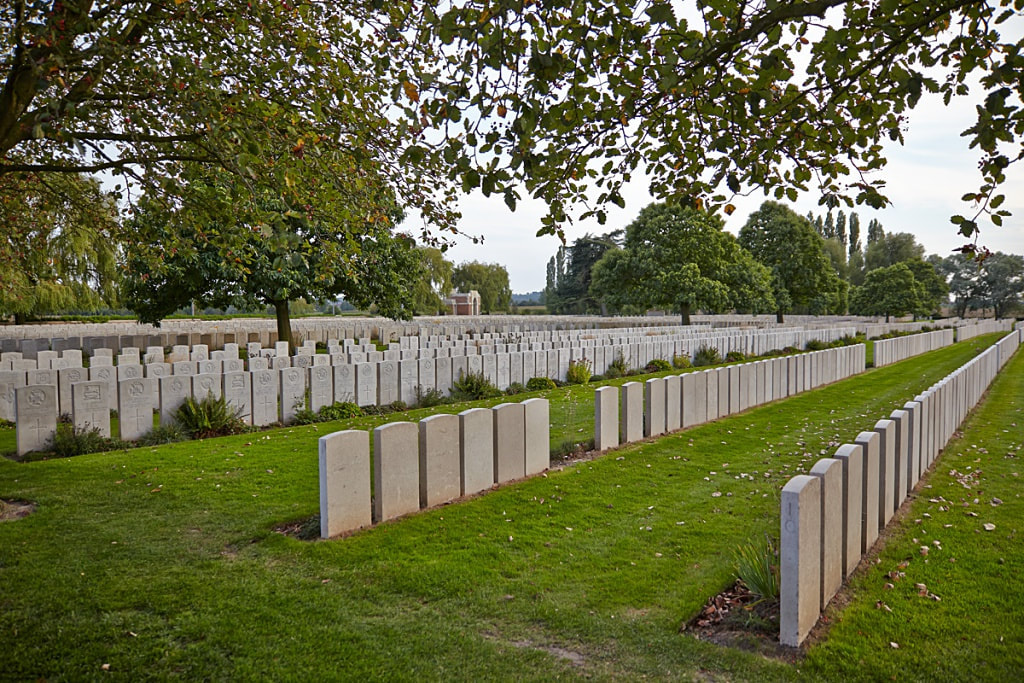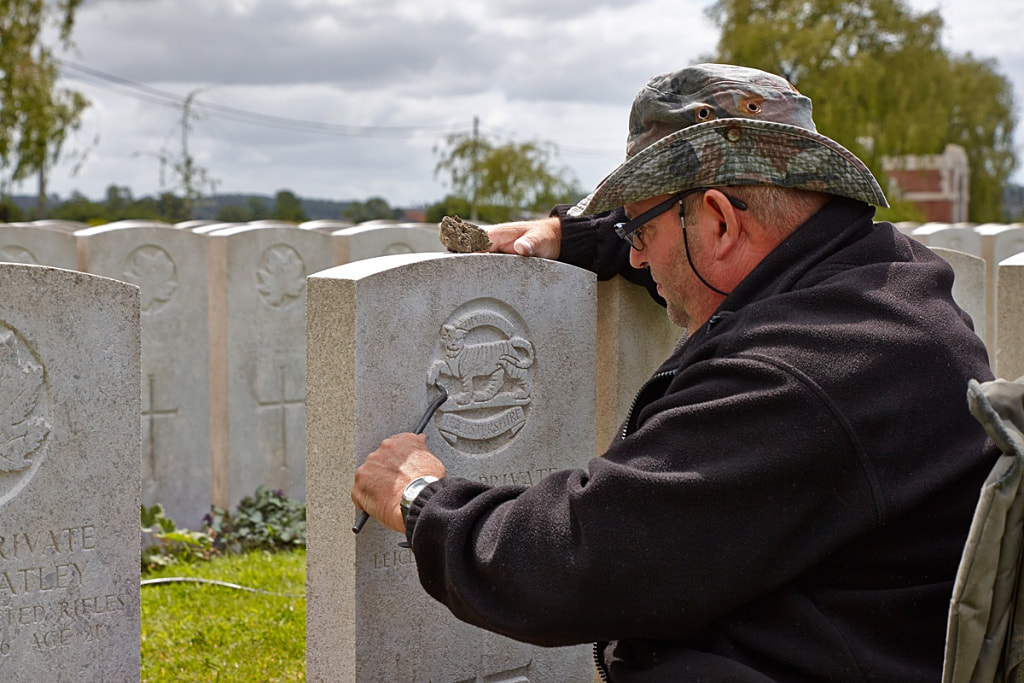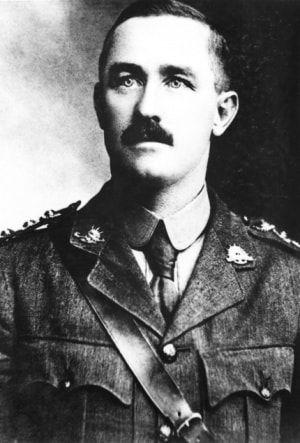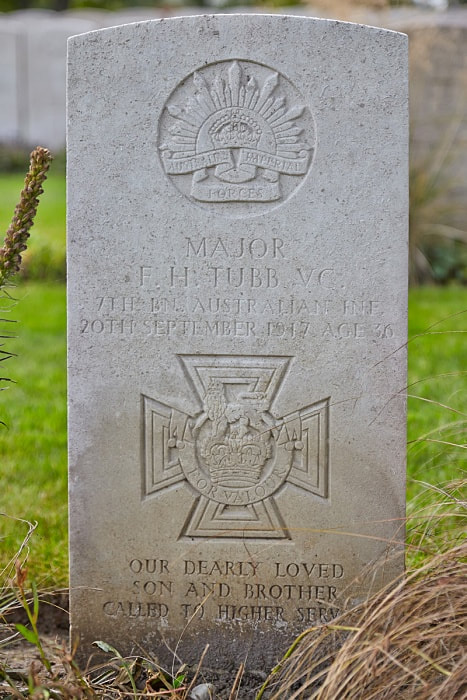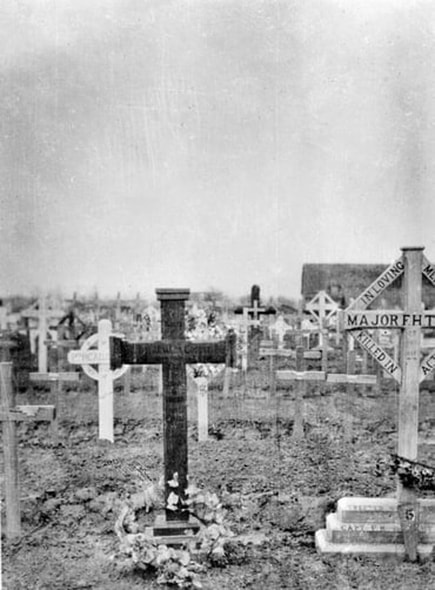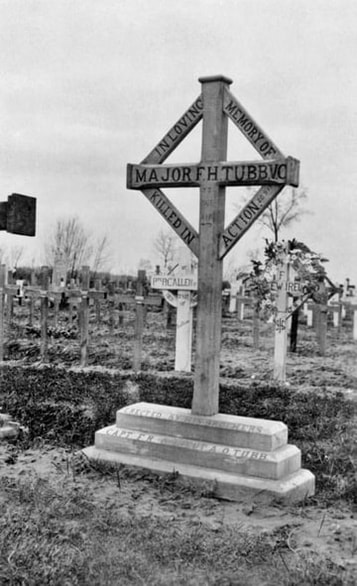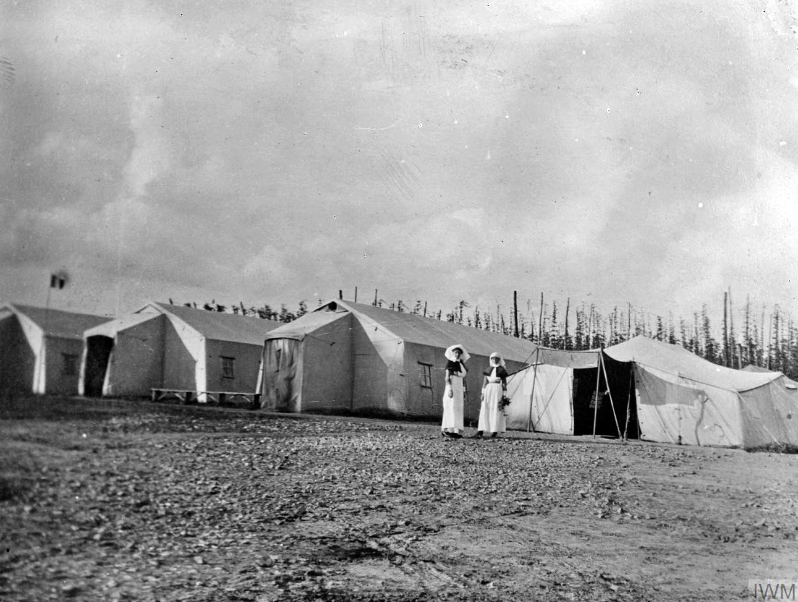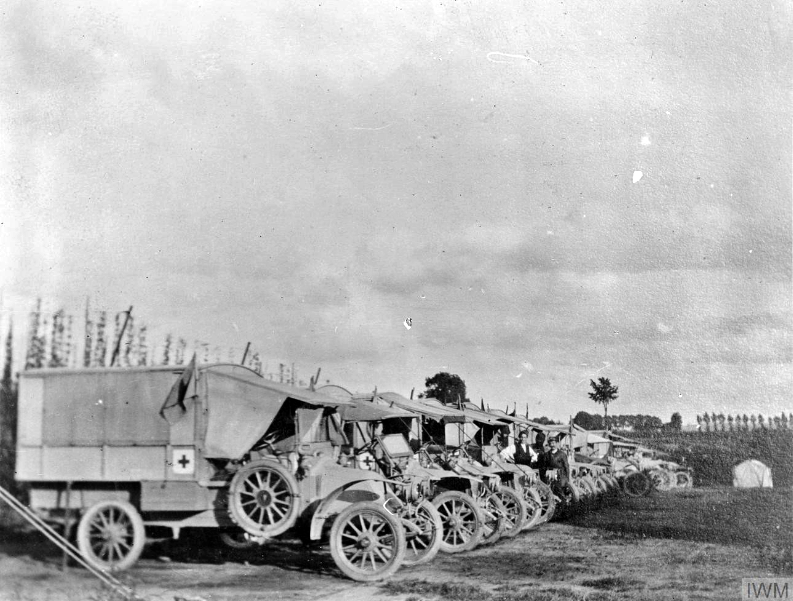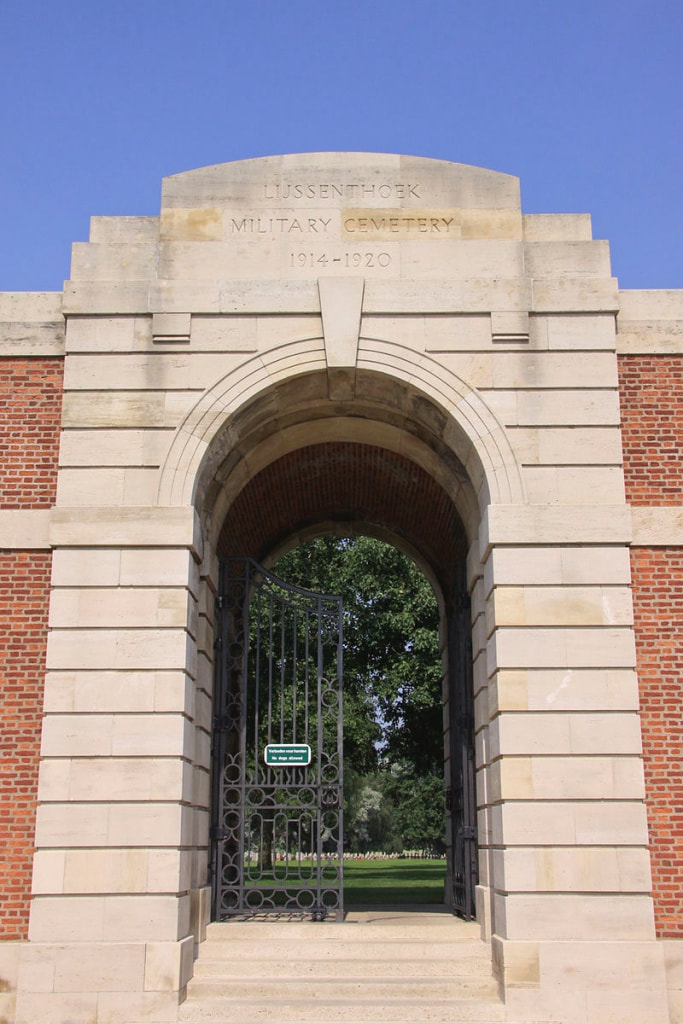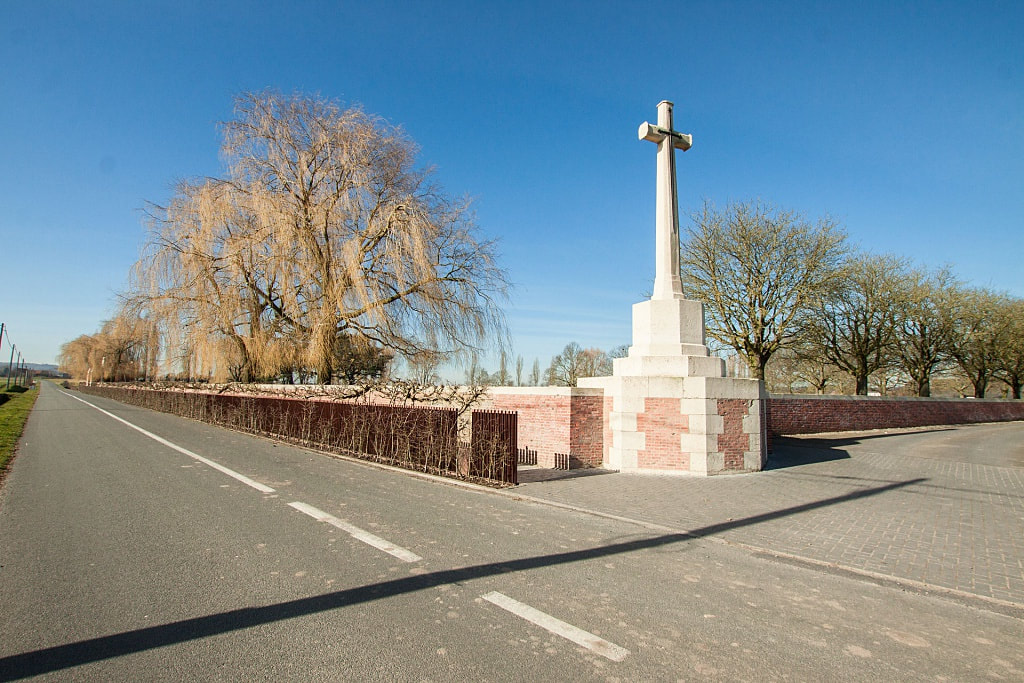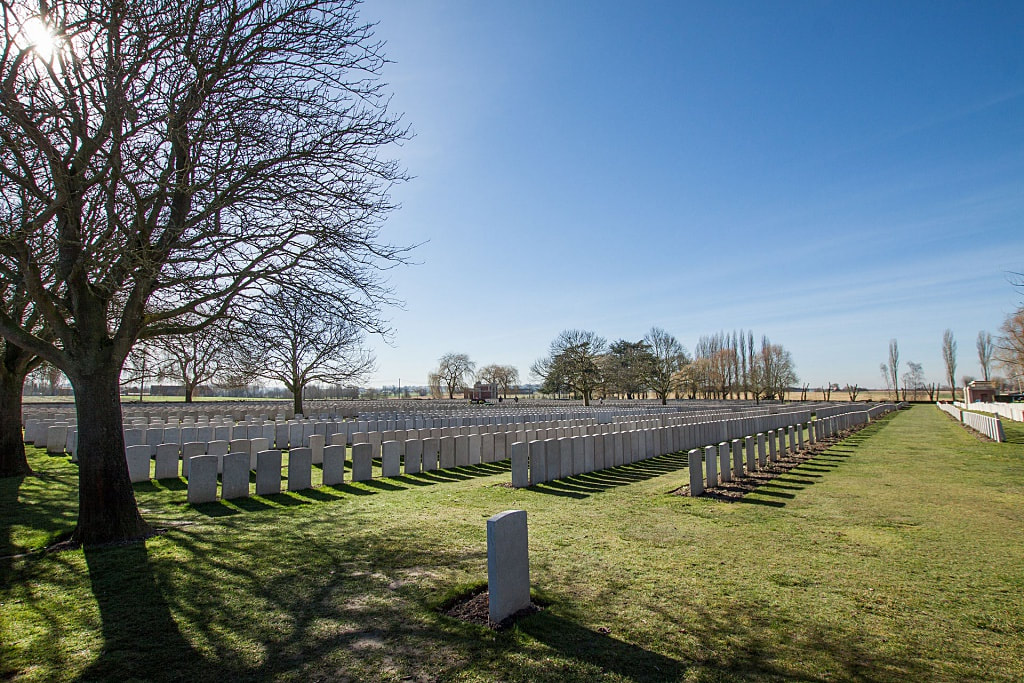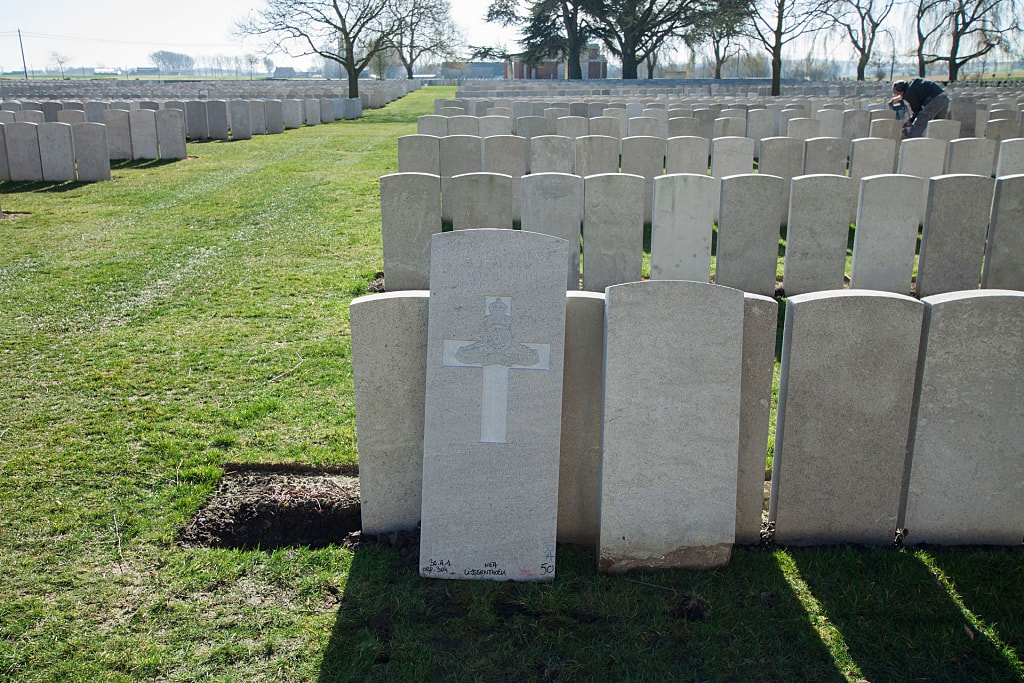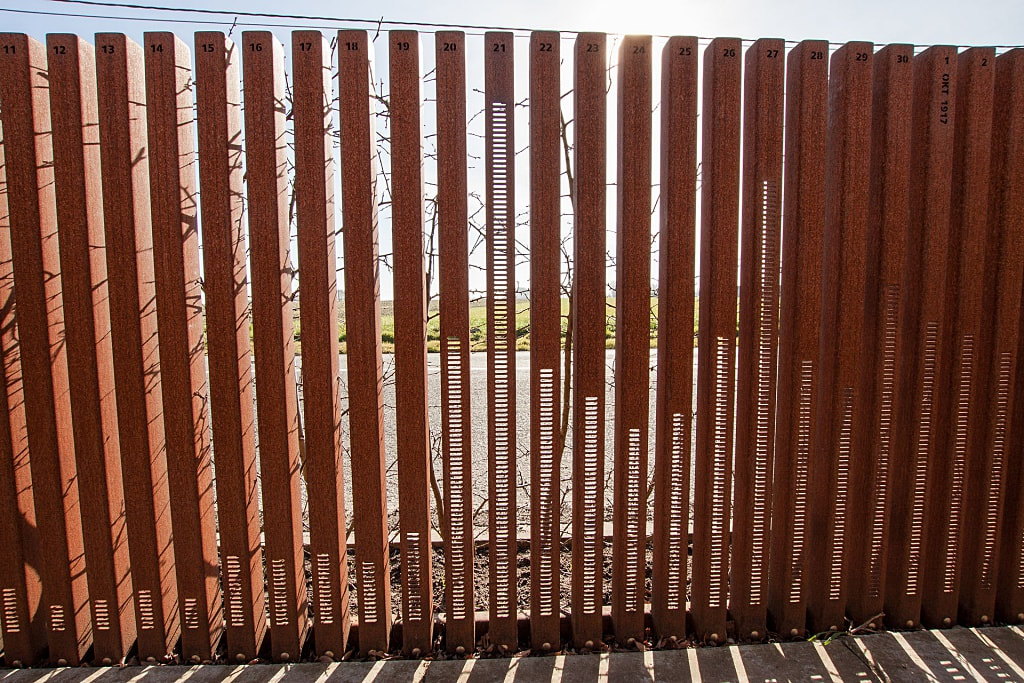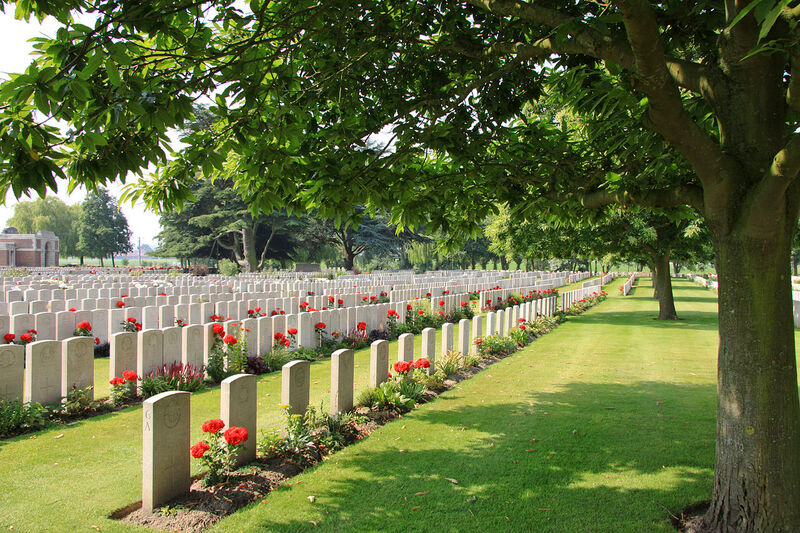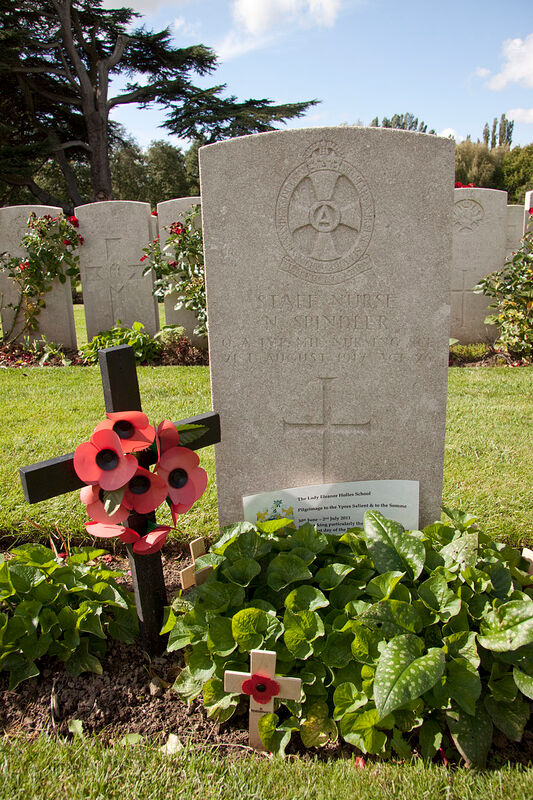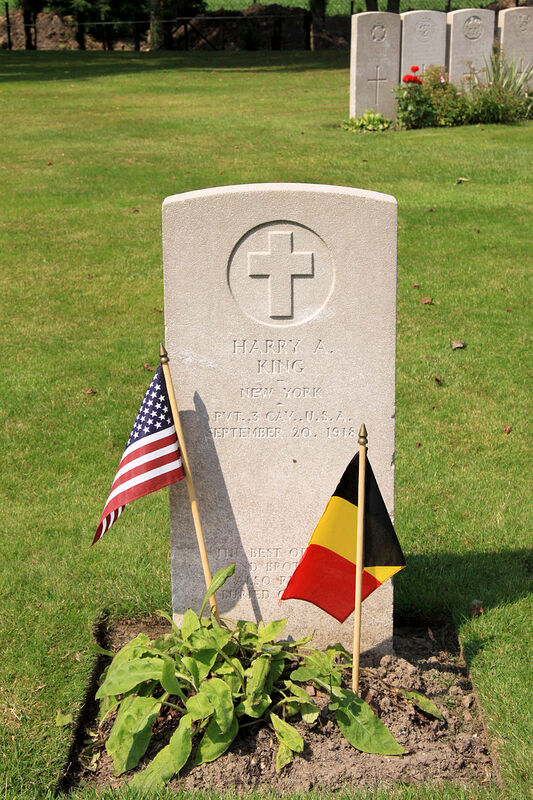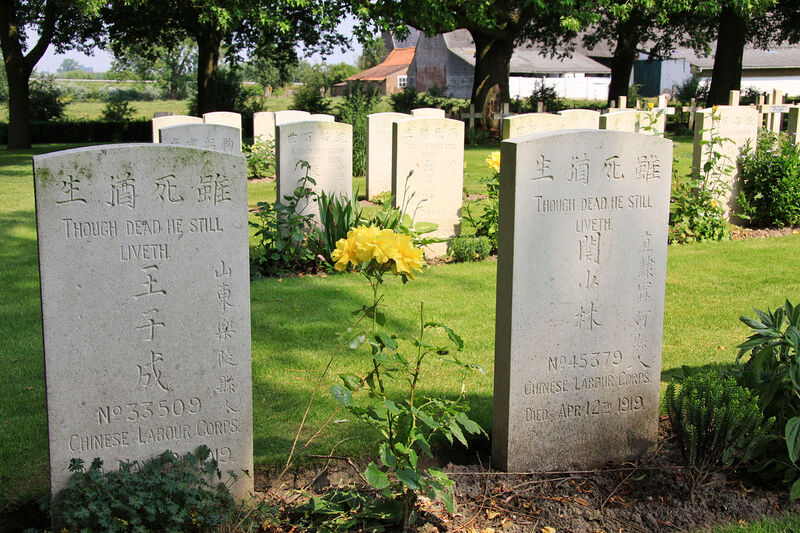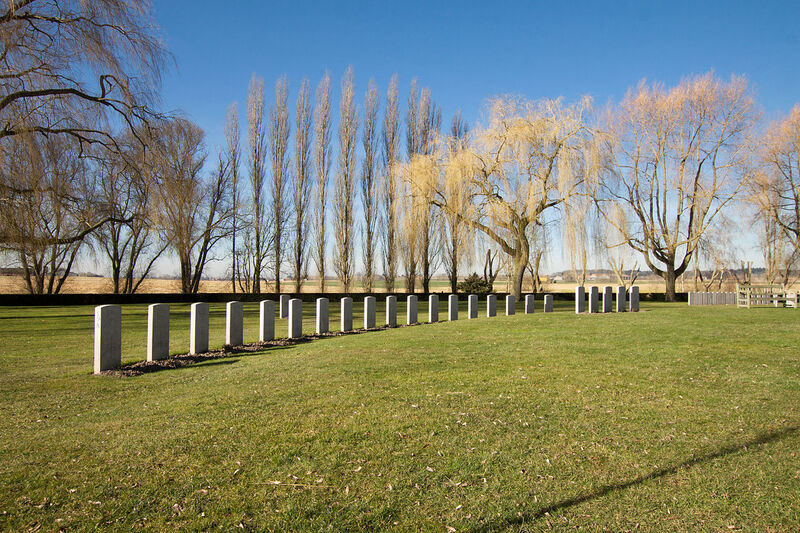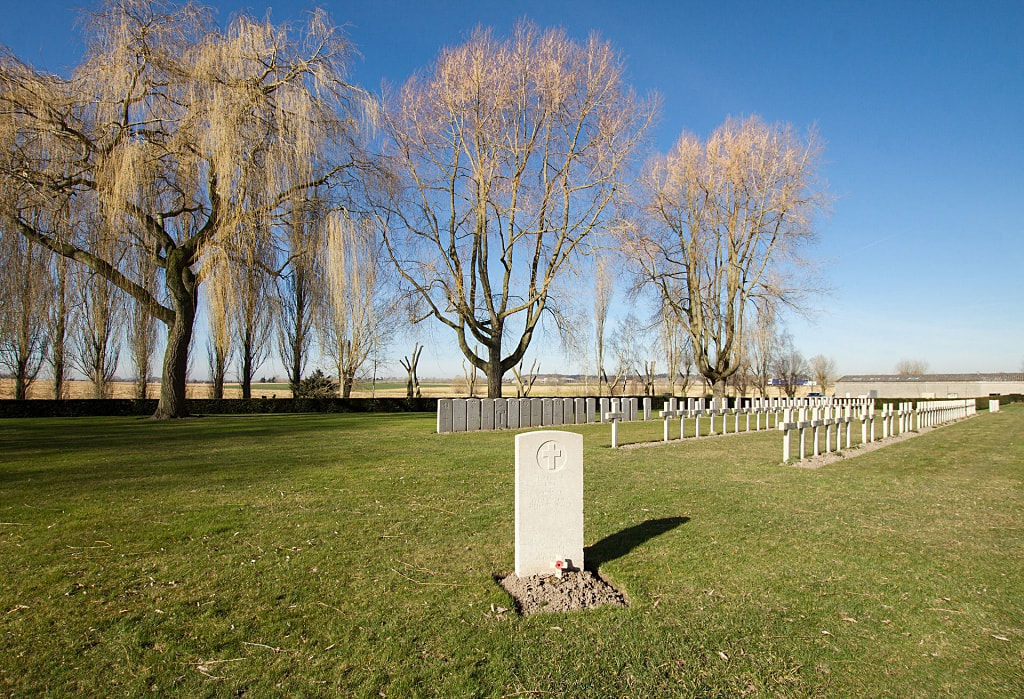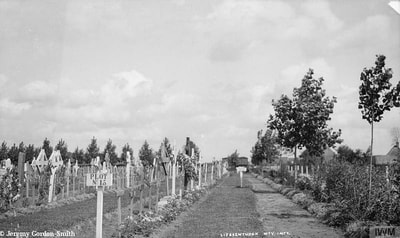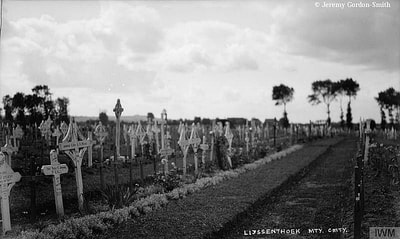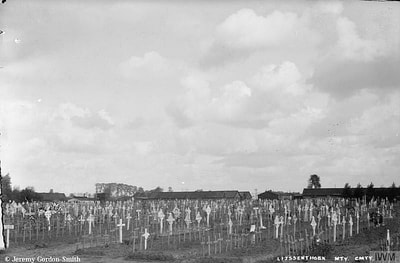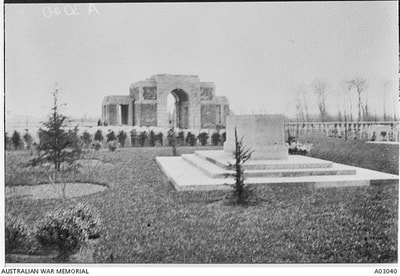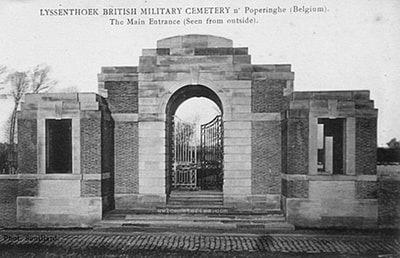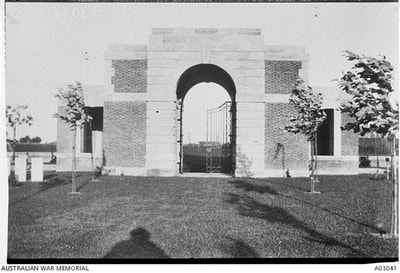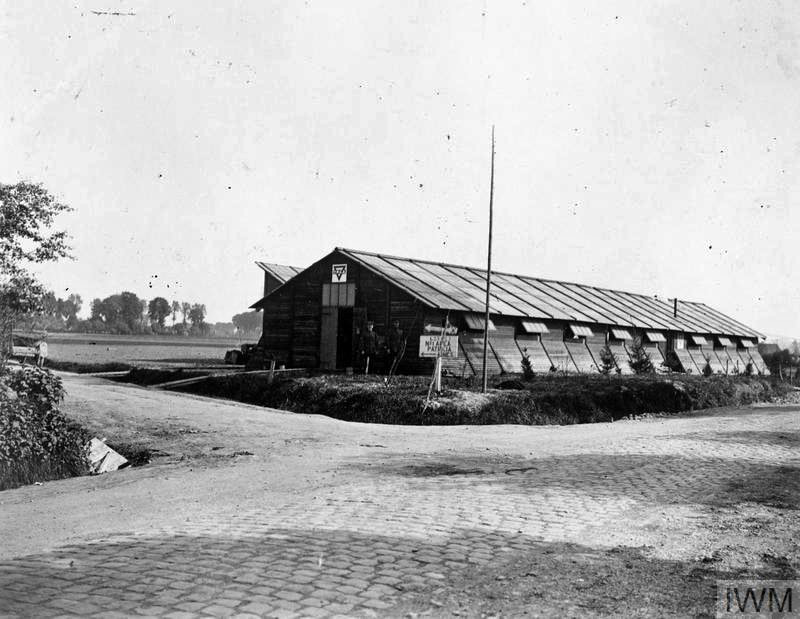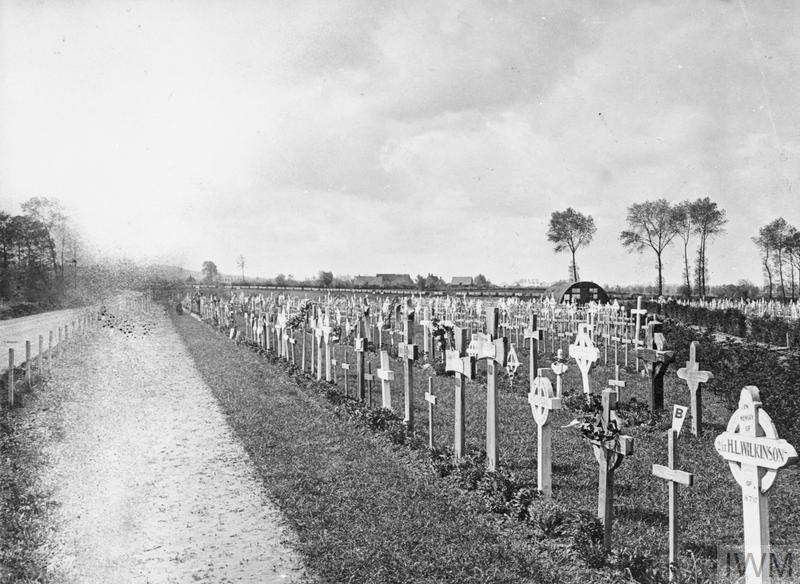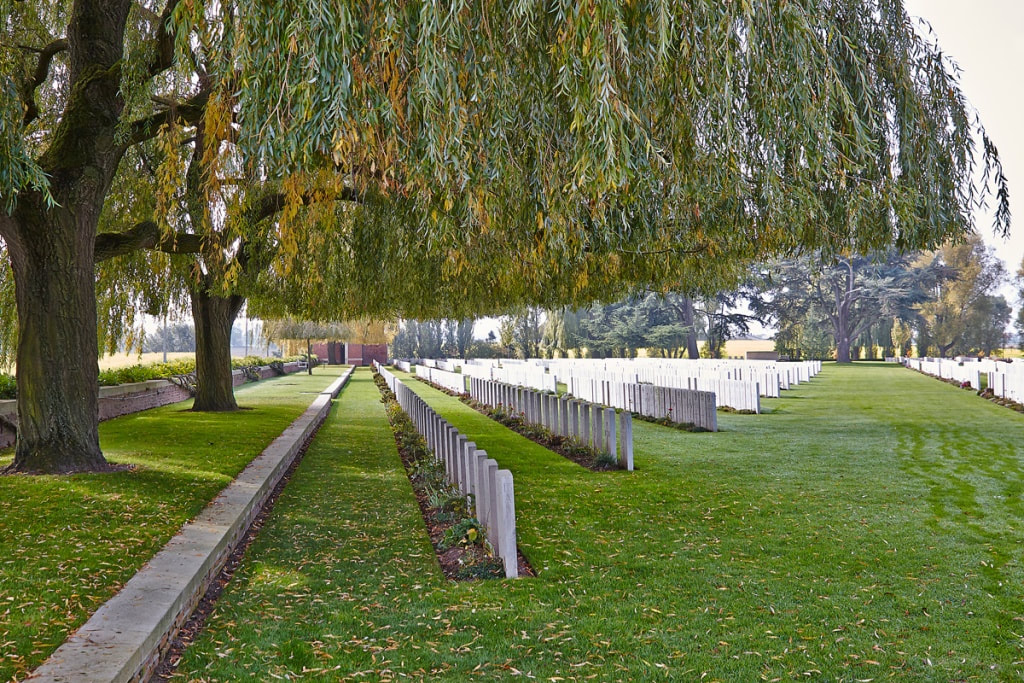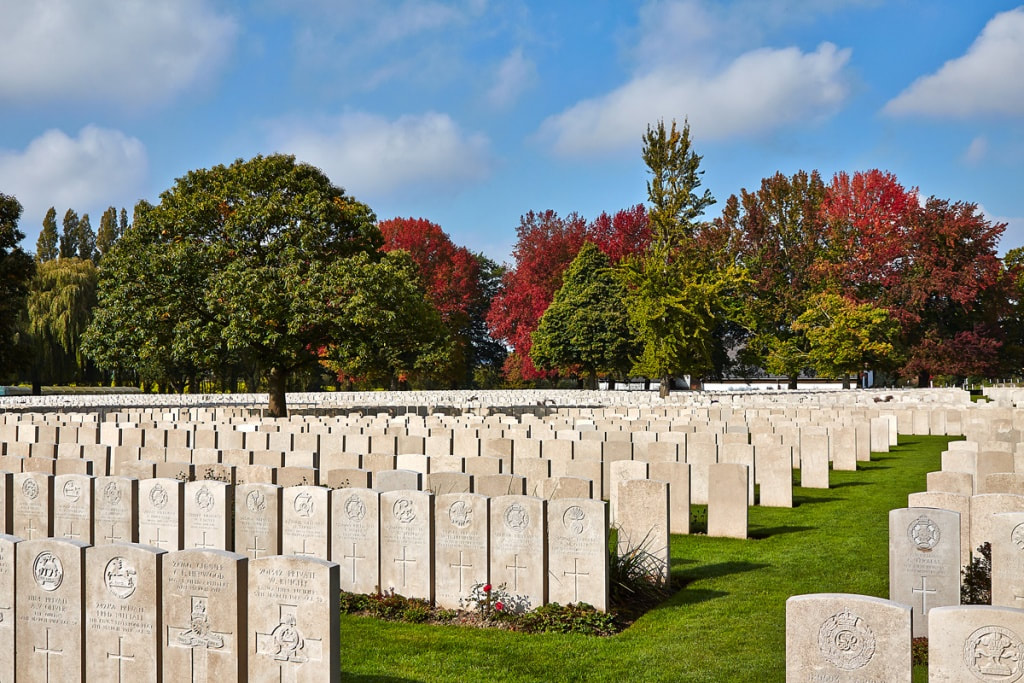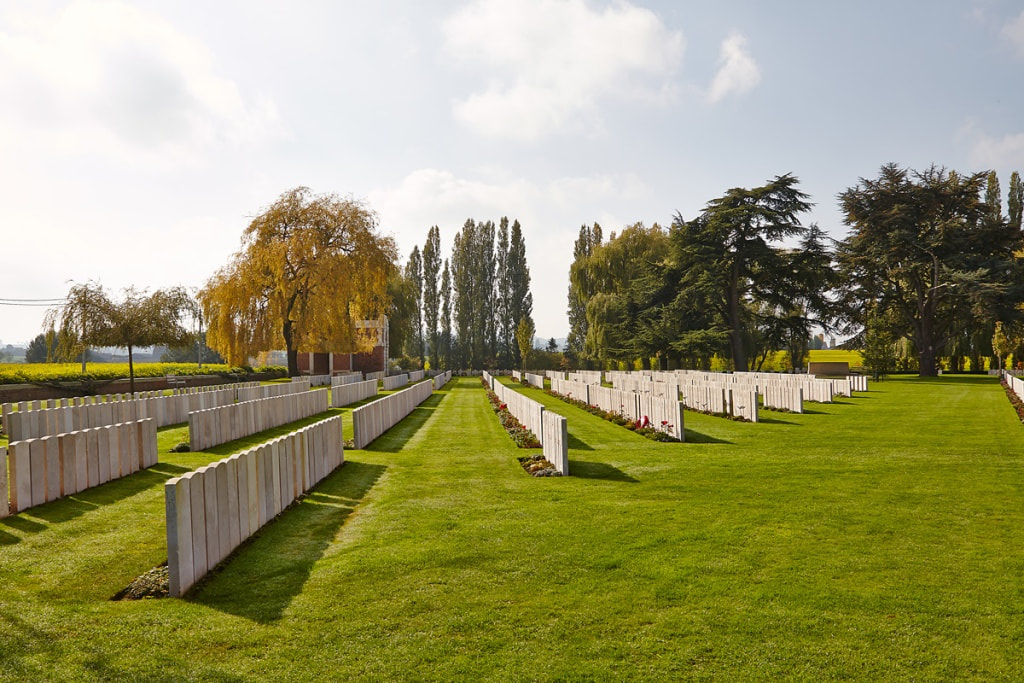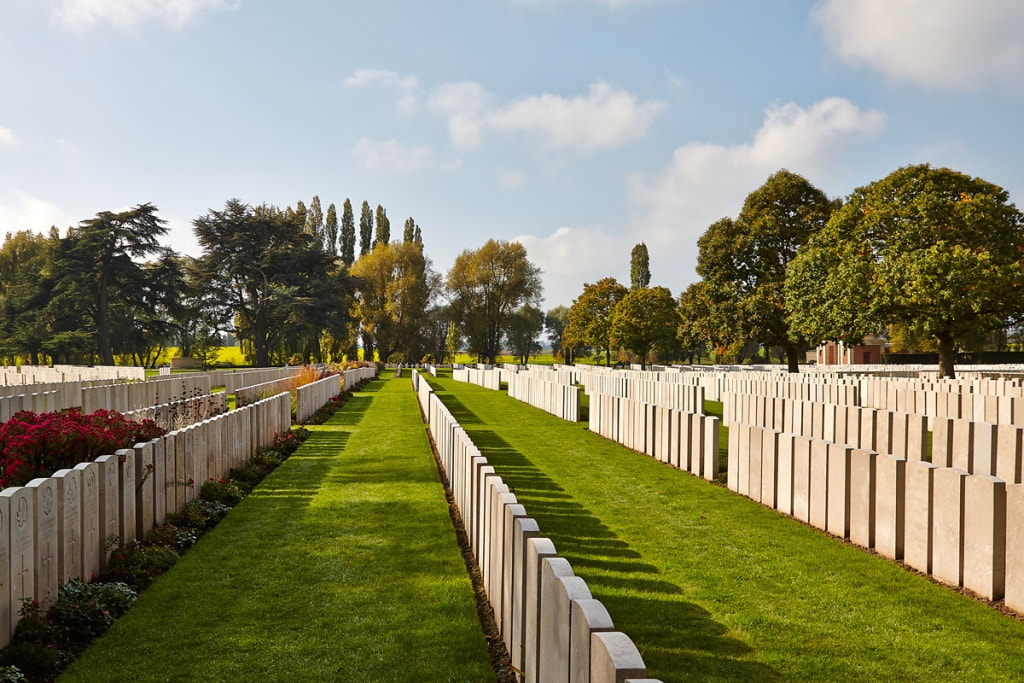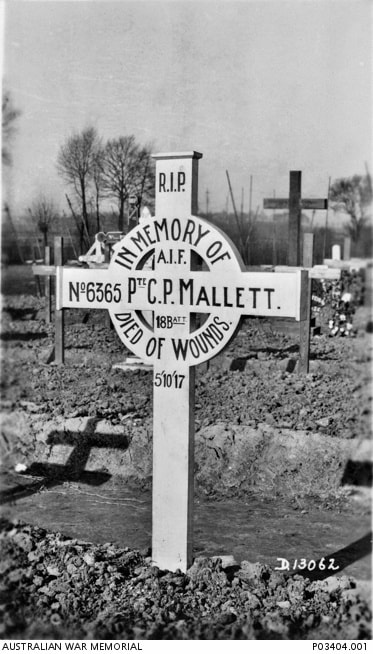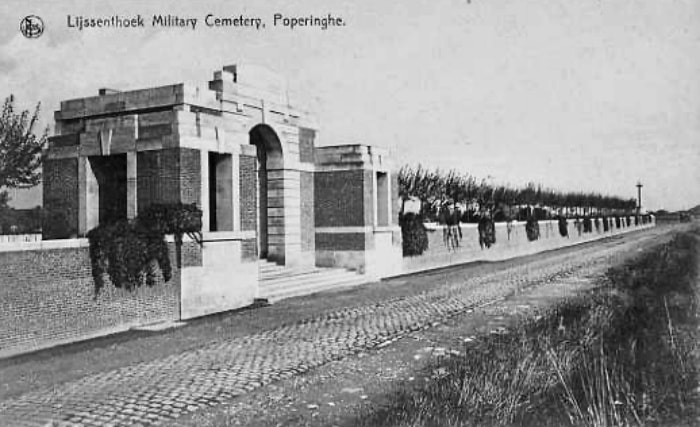LIJSSENTHOEK MILITARY CEMETERY
West-Vlaanderen
Belgium
GPS Coordinates: Latitude: 50.828286, Longitude: 2.701410
Location Information
Lijssenthoek Military Cemetery is located 12 Kms west of Ieper town centre, on the Boescheepseweg, a road leading from the N308 connecting Ieper to Poperinge.
From Ieper town centre the Poperingseweg (N308) is reached via the Elverdingestraat, then over two small roundabouts in the J. Capronstraat. The Poperingseweg is a continuation of the J. Capronstraat and begins after a prominent railway level crossing.
On reaching Poperinge, the N308 joins the left hand turning onto the R33, Poperinge ring road. The R33 ring continues to the left hand junction with the N38 Frans-Vlaanderenweg. 800 metres along the N38 lies the left hand turning onto Lenestraat. The next immediate right hand turning leads onto Boescheepseweg. The cemetery itself is located 2 Kms along Boescheepseweg on the right hand side of the road.
Historical Information
During the First World War, the village of Lijssenthoek was situated on the main communication line between the Allied military bases in the rear and the Ypres battlefields. Close to the Front, but out of the extreme range of most German field artillery, it became a natural place to establish casualty clearing stations. The cemetery was first used by the French 15th Hopital D'Evacuation and in June 1915, it began to be used by casualty clearing stations of the Commonwealth forces.
From April to August 1918, the casualty clearing stations fell back before the German advance and field ambulances (including a French ambulance) took their places.
The cemetery contains 9,901 Commonwealth burials of the First World War, 24 being unidentified. There are 883 war graves of other nationalities, mostly French and German, 11 of these are unidentified. There is 1 Non World War burial here.
The only concentration burials were 24 added to Plot XXXI in 1920 from isolated positions near Poperinghe and 17 added to Plot XXXII from St. Denijs Churchyard in 1981.
Eight of the headstones are Special Memorials to men known to be buried in this cemetery, these are located together alongside Plot 32 near the Stone of Remembrance.
Total Burials: 10,785.
Commonwealth Identified Burials: United Kingdom 7,366, Australia 1,131, Canada 1,058, New Zealand 291, South Africa 28, India 3. Total 9,877.
Commonwealth Unidentified Burials: 24.
Other Burials: 883.
Non World War Burial: 1.
The cemetery, designed by Sir Reginald Blomfield and Arthur James Scott Hutton and is the second largest Commonwealth cemetery in Belgium.
Lijssenthoek Military Cemetery is located 12 Kms west of Ieper town centre, on the Boescheepseweg, a road leading from the N308 connecting Ieper to Poperinge.
From Ieper town centre the Poperingseweg (N308) is reached via the Elverdingestraat, then over two small roundabouts in the J. Capronstraat. The Poperingseweg is a continuation of the J. Capronstraat and begins after a prominent railway level crossing.
On reaching Poperinge, the N308 joins the left hand turning onto the R33, Poperinge ring road. The R33 ring continues to the left hand junction with the N38 Frans-Vlaanderenweg. 800 metres along the N38 lies the left hand turning onto Lenestraat. The next immediate right hand turning leads onto Boescheepseweg. The cemetery itself is located 2 Kms along Boescheepseweg on the right hand side of the road.
Historical Information
During the First World War, the village of Lijssenthoek was situated on the main communication line between the Allied military bases in the rear and the Ypres battlefields. Close to the Front, but out of the extreme range of most German field artillery, it became a natural place to establish casualty clearing stations. The cemetery was first used by the French 15th Hopital D'Evacuation and in June 1915, it began to be used by casualty clearing stations of the Commonwealth forces.
From April to August 1918, the casualty clearing stations fell back before the German advance and field ambulances (including a French ambulance) took their places.
The cemetery contains 9,901 Commonwealth burials of the First World War, 24 being unidentified. There are 883 war graves of other nationalities, mostly French and German, 11 of these are unidentified. There is 1 Non World War burial here.
The only concentration burials were 24 added to Plot XXXI in 1920 from isolated positions near Poperinghe and 17 added to Plot XXXII from St. Denijs Churchyard in 1981.
Eight of the headstones are Special Memorials to men known to be buried in this cemetery, these are located together alongside Plot 32 near the Stone of Remembrance.
Total Burials: 10,785.
Commonwealth Identified Burials: United Kingdom 7,366, Australia 1,131, Canada 1,058, New Zealand 291, South Africa 28, India 3. Total 9,877.
Commonwealth Unidentified Burials: 24.
Other Burials: 883.
Non World War Burial: 1.
The cemetery, designed by Sir Reginald Blomfield and Arthur James Scott Hutton and is the second largest Commonwealth cemetery in Belgium.
Images in this gallery © Geerhard Joos
Major Frederick Harold Tubb V. C.
7th Bn. Australian Infantry
died of wounds 20th September 1917,
Plot XIX. C. 5.
Son of Harry and Emma E. Tubb, of St. Helena, Longwood East, Victoria, Australia. Of Longwood.
His headstone bears the inscription "Our Dearly Loved Son And Brother Called To Higher Service"
Frederick Tubb was born at 'St Helena' Longwood on 28 November 1881. Educated at East Longwood State School, he left to manage his father's property and become a grazier in his own right. He was active in the community, being secretary to the local Mechanics' Institute and a member of the gun and tennis clubs. An excellent horseman, Tubb served in the Victorian Mounted Rifles, the Australian Light Horse and the 60th (Princes Hill) Infantry Regiment. His interest in the military continued when he joined the 58th Infantry Regiment (Essendon Rifles) in 1913, in which he held a commission as second lieutenant at the outbreak of the First World War.
Tubb enlisted in the AIF on 24 August 1914, only 20 days after the proclamation of war, and was posted as a second lieutenant to the 7th Battalion, under the command of Lieutenant Colonel Harold 'Pompey' Elliott. He was promoted lieutenant on 3 February 1915 and captain on 6 August, three days before the action at Lone Pine, Gallipoli, for which he was awarded the Victoria Cross.
Due to wounds he received in the battle, Tubb was invalided to England and took no further part in the Gallipoli campaign. While recuperating, further surgery was required to remove his appendix on 27 December. Physically weak due to effects of the wounds and exacerbated by the surgery, Tubb was sent to Australia to convalesce in March 1916. When asked by reporters on his return to describe his Victoria Cross action he replied 'I did not do a darned thing, when you consider what 6000 other fellows did but they did not survive that terrible four days and I did'. He left Australia in early October and rejoined his battalion, now in France, on 10 December.
Tubb was promoted to the rank of major in February 1917. In June, he again became ill and was invalided to England, rejoining his unit on 7 August. On the 20th of the following month the battalion took part in the fighting around Passchendaele. Near Polygon Wood, Tubb's company seized nine pillboxes only to come under allied shelling when the supporting artillery barrage fell short. Tubb was mortally wounded by one of the shells and died later that evening.
Major Frederick Tubb is buried in the Lijssenthoek Military Cemetery near Poperinge, Belgium. His original cross was erected by his brothers, Lieutenant Arthur Oswald Tubb, Sapper Alfred Charles Tubb and Captain Frank Reid Tubb. Frank Tubb also served in the 7th Battalion, being awarded a Military Cross in fighting around Pozieres in August 1916.
Citation
An extract from "The London Gazette," No. 29328 dated 15th Oct., 1915, records the following:-For most conspicuous bravery and devotion to duty at Lone Pine trenches, in the Gallipoli Peninsula, on 9th August, 1915. In the early morning the enemy made a determined counter attack on the centre of the newly captured trench held by Lieutenant Tubb. They advanced up a sap and blew in a sandbag barricade, leaving only one foot of it standing, but Lieutenant Tubb led his men back, repulsed the enemy, and rebuilt the barricade. Supported by strong bombing parties, the enemy succeeded in twice again blowing in the barricade, but on each occasion Lieutenant Tubb, although wounded in the head and arm, held his ground with the greatest coolness and rebuilt it, and finally succeeded in maintaining his position under very heavy bomb fire.
Headstone
Shot at Dawn
22635 Private William Baker, 26th Bn. Royal Fusiliers, executed for desertion 14th August 1918, plot XXV. B. 22. Son of Mrs. Elizabeth Baker, of 13, Russell St., Plaistow, London. He was already under arrest, when on 22 April 1918 he absented himself. On 18 May, he was arrested again near the mail-boat at Boulogne, having given a false name & particulars. He escaped again, but was finally arrested, when attempting admittance, again using a false name, to a hospital at Etaples. (Putkowski, p 254)
22635 Private William Baker, 26th Bn. Royal Fusiliers, executed for desertion 14th August 1918, plot XXV. B. 22. Son of Mrs. Elizabeth Baker, of 13, Russell St., Plaistow, London. He was already under arrest, when on 22 April 1918 he absented himself. On 18 May, he was arrested again near the mail-boat at Boulogne, having given a false name & particulars. He escaped again, but was finally arrested, when attempting admittance, again using a false name, to a hospital at Etaples. (Putkowski, p 254)
Images in this gallery © Werner Van Caneghem
Archive Pictures
(Click to enlarge)
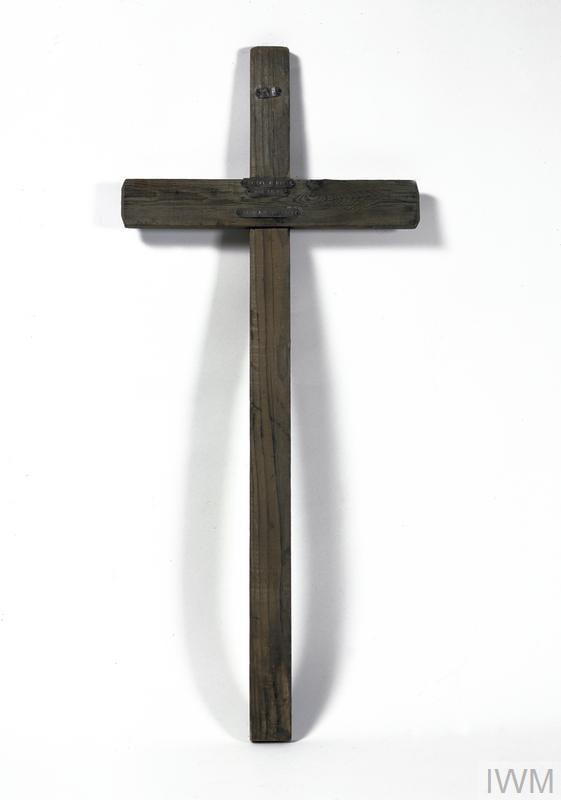
Wooden cross from the grave of Sergeant H Lewis Burt Sergeant Burt was first wounded in April 1915 while serving with the Motor Machine Gun Service. He transferred to the Tank Corps and on 22 August 1917 was wounded during the Third Battle of Ypres (Passchendaele). He died two days later at No 2 Canadian Casualty Clearing Station. He is buried in Lijssenthoek Military Cemetery near Ypres. He now lies in plot XVIII. D. 17A. © IWM (EPH 950)
Images in this gallery © Geerhard Joos

1920's image of the headstone of 2824 Sergeant Joseph Church Daley, 56th Australian Infantry Battalion which is located in the Lijssenthoek Military Cemetery, Belgium.
A clerk from Bexley, NSW, Sgt Daley enlisted on 18 July 1915 and joined the 4th Battalion. Transferred to the 56th Battalion, Daley arrived on the Western Front on 29th June 1916 and after receiving various promotions, was wounded and eventually died of his wounds on the 30th September 1917 at the 10th Casualty Clearing Station, Belgium.




